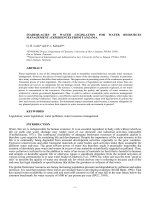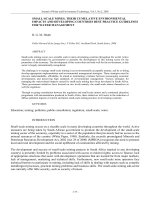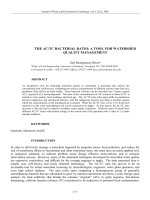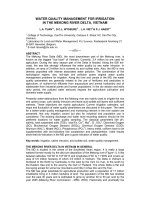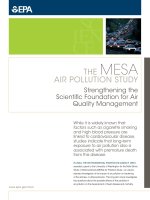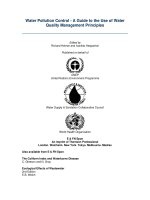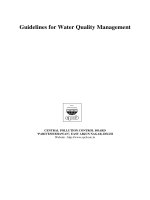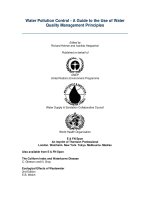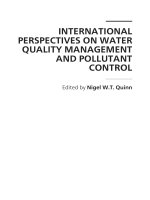Guidelines for Water Quality Management: CENTRAL POLLUTION CONTROL BOARD ‘PARIVESH BHAWAN’, EAST ARJUN NAGAR, DELHI pptx
Bạn đang xem bản rút gọn của tài liệu. Xem và tải ngay bản đầy đủ của tài liệu tại đây (1.08 MB, 41 trang )
Guidelines for Water Quality Management
CENTRAL POLLUTION CONTROL BOARD
‘PARIVESH BHAWAN’, EAST ARJUN NAGAR, DELHI
Website :
1. Introduction
2. Step-I Setting Water Quality Goal
3. Step-II Water Quality Monitoring
4. Step-III Identification of Nature and Magnitude of Pollution
5. Step-IV Source Inventory
6. Step - V Water Quantity information
7. Step -VI Selection of Technology
8. Step -VII Financing Waste Management
9. Step – VIII Maintenance of sewage treatment plants
10. Step – IX Pollution from industrial sources
11. Step – X Pollution from non-point sources
12. Step – XI Some other Important Options for Water Quality Management
Annexure-1 Procedure for setting water quality goals
Annexure-2 Water Quality Monitoring Protocol
Annexure-3 Polluted River Stretches Identification and Action Plan to Control of
Water Pollution
Annexure-4 Guidelines for Assessment of Pollution Sources and Estimation of
Pollution Load in a Polluted Stretch
Annexure-5 Some Important Options for Restoration of Water Quality in a Water
Body
1. Introduction
Water is most essential but scarce resource in our country. Presently the quality & the availability of the fresh water
resources is the most pressing of the many environmental challenges on the national horizon. The stress on water
resources is from multiple sources and the impacts can take diverse forms. Geometric increase in population
coupled with rapid urbanization, industrialization and agricultural development has resulted in high impact on
quality and quantity of water in our country. The situation warrants immediate redressal through radically improved
water resource and water quality management strategies. The present document highlights the steps involved in
preparation of a water quality management plan in a rational manner.
2. Step-I Setting Water Quality Goal
¾ For preparation of water quality management plan the first step is to identify water quality goal for the
water body in question.
¾ To set the water goal one has to identify use(s) of water (please refer Annexure 1) in the given water body
or its part in question.
¾ If the water body is used for more than one use than identify the use , which demands highest quality of
water called “designated best use”.
¾ Identify the water quality requirements for that “designated bast use” in terms of primary water quality
criteria.
3. Step-II Water Quality Monitoring
¾ Water quality monitoring is to be carried to acquire the knowledge on existing water quality of the
water body.
¾ Water Quality Assessment Authority has notified a “Protocol for Water Quality Monitoring” (Annexure
2) .
¾ This protocol should be followed to monitor the water quality.
4. Step-III Identification of Nature and Magnitude of Pollution
¾ After repeated observations on water quality covering different seasons, the water quality data should
be compiled and compared with the desired quality requirement as per the water quality goal set in
step-I. Using this exercise CPCB has identified polluted water bodies in the country (Annexure 3)
¾ This comparison would lead to identification of the gaps with respect one or more parameter(s) and also
extent of gap, which will ultimately help in identification of nature and magnitude of pollution control
needed.
5. Step-IV Source Inventory
¾ Once the nature and magnitude of pollution is identified, it is important that the source(s) of such
pollution is/are identified.
¾ Inventorise the number of outfalls joining the water body for identification of point sources (Inventory
form Annexure 4).
¾ Measure the quality and quantity of wastewater flowing through each of the outfalls.
¾ For each outfall pollution load joining per unit time (normally per day) should be measured in terms of
important pollutants. This exercise requires continuous sampling for 24/48/72 hours on flow based
composite basis.
¾ The pollution load joining through all the important outfalls should be measured.
¾ Inventorise the human activities in the upstream catchments area of the water body to identify the non-
point sources of pollution. The activities could be open defication, unsewered sanitation, uncollected
garbage sewage and industrial wastes, commercial wastes in case of urban or industrial areas and
application of agrochemicals in case of rural areas.
6. Step – V Water Quantity information
¾ In case of river or stream acquire the flow data from CWC, State Irrigation Deptt. For atleast last 5
years or more.
¾ In case of lakes, reservoirs collect the information on water levels for atleast last 5 to 10 years
¾ Carry out mass balance to estimate the dilution available in different seasons.
¾ Estimate the least dilution available in last 5 years.
¾ Assess the assimilation capacity by applying simple streeter-phelps equation and generate different
scenario to estimate the extent of pollution control required.
¾ This exercise would give precisely how much pollution load needs to be reduced to achieve the desired
water quality.
7. Step – VI Selection of Technology
¾ Simpler technology should be adopted for sewage treatment.
¾ Treatment scheme based on series of Waste Stabilization Ponds (WSP) technology is quit rugged, one of
the most economical ones and suitable for small towns where sufficient land is easily available. Multiple
stage ponds (at least three) with first pond as anaerobic one is the most widely used and suitable
configuration.
¾ Sewage collection and treatment being primary responsibility of local authorities.
¾ Many times sewage can be found flowing in open drains in most of the cities, as these do not have full
sewerage Low strength sewage received from open drains is not ideal for anaerobic biological treatment as
recovery of use full byproduct, biogas, is meager.
¾ Simpler option of treatment such as series of waste stabilization ponds may prove to be cost effective in such
conditions.
¾ There is scope to reduce the cost of the material used for laying down the sewers.
¾ Use of low volume flushing tanks will help in reducing waste water volume and thereby cost of sewerage and
sewage treatment.
¾ For low income housing colonies either two pit pour flush water seal latrines or a shallow sewer could a possible
option.
¾ Co-operative group housing societies, multi storied housing complexes, big hotels etc. need to set up appropriate
on-site waste water treatment facilities for recycling of waste water for gardening and other non-domestic uses to
the extent feasible.
¾ Renovation of existing drainage system, which currently acts as open sewers, and dovetailing the renovated
drainage system to appropriate forestry programme or tree plantation, will reduce sewage treatment cost.
¾ The options which are available for cost-effective and environmentally compatible sewage treatment include
land treatment, waste stabilization ponds, constructed wetlands, duck-weed pond, aerated lagoon, rotating
biological contractors, up-flow anaerobic sludge blanket system and root zone treatment.
¾ Top layer of soil under the vegetative cover maintains microenvironment within which soil flora and fauna
decompose the organic matter. Thus, top layer of soil can be utilized for the treatment of domestic sewage and
variety of biodegradable wastewaters (root-zone treatment). Land treatment can tolerate fluctuation in loading
more readily than conventional processes. This technology is well established in U.S.A., Canada, Australia, and
U.K. and also attempted in China and few other developing countries including India. The Central Pollution
Control Board has evolved guidelines on application of this technology in Indian condition.
¾ The use of biotechnology could be another option for waste treatment under NRCD particularly with respect to
organic pollution. Inorganic pollutants like nitrogen, and phosphorus can also be removed by this technology.
8. Step - VII Financing Waste Management
Effluent Tax
¾ Today there is no provision for collection and treatment of about 22000 mld of wastewater. With fast
urbanization this quantity will be about 40,000 mld by the end of 11
th
Plan. Each mld cost about Rs. 1
crore for establishing treatment facilities and about 4 crores for collection facilities. This makes total
requirement of funds in the tune of more than one lakh crores just for establishing facilities. The
operation and maintenance may be another about 10% of the above cost every year. Funding of such
schemes from exchequer’s fund in order to achieve the goals, as is being done today under NRCP,
would be detrimental to the economy of the country.
¾ The present approach of financing the waste management is neither adequate nor effective in tackling
the massive problem water quality degradation. Thus the approach needs to be changed.
¾ The major part of the cost on waste management should be born by the urban population according to
‘polluter pay principle’.
¾ It can be applied to any dischargers, cities or industries, with two benefits; it induces waste reduction
and treatment and can provide a source of revenue for financing wastewater treatment investments.
¾ Municipal wastewater treatment is a particularly costly and long-term undertaking so that sound
strategic planning and policies for treatment are of special importance.
¾ Pricing and demand management are important instruments for encouraging efficient domestic and
industrial water-use practices and for reducing wastewater volumes and loads.
¾ Water and sewerage fees can induce urban organisations to adopt water-saving technologies, including
water recycling and reuse systems, and to minimise or eliminate waste products that would otherwise
end up in the effluent stream.
¾ In addition to price based incentives, demand management programmes should include educational and
technical components, such as water conservation campaigns, advice to consumers, and promotion,
distribution or sale of water-saving devices like "six-litre" toilets which use less than half the volume of
water per flush than a standard toilet.
Beneficiaries
It is also important to consider the beneficiaries. The waste management benefits following:
1. Local citizens
2. Protection of environment
3. Protection of Public health
4. Protection of water resources – water supply, irrigation, other uses
5. Protection of industrial use
6. Enhanced Property values
7. Enhanced tourism
All the above agencies may contribute to waste management. A mechanism can be evolved to coordinate with all the
beneficiaries and charge them the benefit tax.
9. Step – VIII Maintenance of sewage treatment plants
¾ Operation and maintenance of the treatment plants, sewage pumping stations is a neglected field, as nearly
39% plants are not conforming to the general standards prescribed under the Environmental (Protection)
Rules for discharge into streams as per the CPCB’s survey report.
¾ STPs are usually run by personals that do not have adequate knowledge of running the STPs and know only
operation of pumps and motors.
¾ The operational parameters are not regularly analyzed hence the day-to-day variation in performance is not
evaluated at most of the STPs. Thus, there is a need that persons having adequate knowledge and trained to
operate the STPs be engaged to manage STPs and an expert be engaged to visit the STPs at least once a
month and advice for improvement of its performance.
¾ In a number of cities, the existing treatment capcity remains underutilized while a lot of sewage is
discharged without treatment in the same city.
¾ Auxiliary power back-up facility is required at all the intermediate (IPS) & main pumping stations (MPS) of
all the STPs. It is very essential that they be efficiently maintained by the local authoritis whose properties and
charge they are.
¾ Inter-agency feuds and inadequate consideration of which agency would be responsible for what has led to
inadequate maintenance of various STPs and other facilities created.
¾ The maintenance of the sewage system, namely, sewers, rising mains, intermediate pumping stations, etc. should
also be entrusted to the nodal agencies identified for the maintenance of the sewage treatment plants and
sufficient funds and staff provided to them.
¾ Facilities like community toilets, electric crematoria, etc. should be maintained by the local bodies. Also the
aspect of resource recovery by way of raising the revenue through sale of treated effluent for irrigation, of sludge
as a manure and biogas utilization for power generation wherever provision exist needs to be addressed. Biogas
generation, pisciculture from sewage as envisaged in the Ganga Action Plan is still in the starting stages.
10. Step – IX Pollution from industrial sources
A. Pollution control at source
¾ The water polluting industries which had not so far installed ETPs should be asked to furnish a time bound
programme to the Ministry of Environment and Forests for treatment of their effluents.
¾ Those who have given commitment under Corporate Responsibility on Environment Protection (CREP) should
adhere to it.
¾ Such programmes should clearly indicate the existing and proposed arrangements with detailed time schedules.
The programme should be backed up by a commitment from the Administrative Ministry concerned or the
respective State Government, as the case may be, to provide the funds as necessary and ensure compliance by
the industries.
¾ If the undertakings and the administrative Ministry/State Government failed to respond, action under the
Environment (Protection) Act need to be taken forthwith thereafter.
¾ SPCBs should monitor the progress and report on the outcome. The SPCBs should examine the prevailing
arrangements in charging water supply for industry and formulate proposals in consultation with the concerned
departments on how the system can be rationalized to conserve water and recycle it for use.
¾ Emerging technologies such as aerobic composting, vermiculture, ferti-irrigation, etc. as secondary treatment
should be adopted for the organic wastes by the industries. Recently, the root-zone technology is also being
advocated is yet another alternative for energy saving for treatment of industrial wastewaters.
¾ Incentives have to be made more attractive to make the industries undertake pollution control measures. It
is important to assess the effectiveness of this measure and work out other measures which would serve as
effective incentives for pollution control.
B. Reuse/recycling of treated industrial waste and resource recovery:
¾ The reuse and recycling of wastes for agricultural purpose would not only help to reduce the pollution and
requirement of fresh water for such use but also would supplement the much needed nutrients and organic
manure to the plants.
¾ The segregation of waste water streams may help in reducing waste water volume and waste strength and may
help recycling and reuse of majority of waste streams. The quantity of the effluent generated in sugar industry
can be reduced from 300 litres to 50 litres per tonne of cane crushed, if recycling techniques are meticulously
followed. The wastewater quantity generated in continuous fermentation distilleries is 7 litres per litre of alcohol
produced, as compared to 14-15 litres per litre of alcohol produced in batch fermentation process distilleries. The
reduction in wastewater quantity is mainly achieved by recycling wash and adopting reboiler system. In pulp and
paper industries, the paper mill wastewater is completely recycled into pulp mill by adopting fibre recovery
system. It has helped to reduce the wastewater from 200 cum to 50 cum per tonne of paper produced.
C. Waste minimization and clean technologies:
¾ It may be noted that by recycling techniques the waste concentrations may increase, however the total load
remain the same. The concentration of waste strength would help the economical conversion of spent wash to
biofertilizer. Waste strength reduction can be achieved by adopting in plant control measures such as reduction
of spillages of wastes, elimination of process failures, use of proper equipment for handling and dry cleaning
techniques etc. This is often termed as clean technologies; it does not add to the cost of production, in fact
industry gains from it.
¾ Innovation in pollution prevention/waste minimization efforts on the part of the industries needs to be sternly
promoted. Pollution prevention/ waste minimization, in our country at least, is done only for product quality
improvement, energy saving or other economic reasons and any reduction in pollution is only incidental.
¾ All organic wastes are best source of energy. A number of anaerobic technologies are now available for
treatment of organic industrial effluents. Spent wash, black liquor (pulp mill), dairy effluents, sugar factory
effluents and press mud etc. are some of the organic wastes tried for energy recovery. The energy recovery will
incidentally solve the air pollution problem, as biogas is a cleaner fuel compared to baggasse, rice husk or coal. It
is essential to introduce energy audit in all the industries so hat cost-benefit ratio can be established in each case.
¾ Bio-fertilizers are now prepared from organic rich wastes by admixing filler materials. Spent wash is converted
to manure by addition of press mud, bagasse cillo, agricultural residues etc. In this technology the entire liquor
effluent is converted into solid mass and it can be termed as "Zero-discharge” technology.
D. Waste water discharge standards and charges on residual pollution
¾ The limits need to be fixed on water use and wastewater generation per unit production for each industry. In order
to achieve this goal, guidelines are to be evolved and the industry should be forced to adopt recycling and reuse
through legislation and vigilance monitoring.
¾ New measures such as imposing charges on residual pollution once the prescribed limits are complied will
have to be introduced to encourage recycle and reuse of effluents and adoption of the zero-discharge
concept.
E. Mixing sewage with industrial waste wherever advantageous
¾ Wherever it is possible, industrial wastes should be combined with domestic wastes for treatment if no toxicity.
¾ Economy of scale, better treatability of industrial waste water and better arrangements for disposal of treated
effluents are some of the advantage of the joint treatment of industrial and domestic effluents.
¾ Contribution from industries to capital expenditure of laying sewers and construction of treatment plant would
render finance to sewerage and treatment schemes.
¾ Joint treatment is attractive for cities and towns and industrial areas surrounded by residential areas.
¾ Baroda and Ahmedabad cities have such joint treatment schemes under a notified charging formula.
¾ It is considered that for small-scale industries located in cities, such joint collection and treatment is a win-win
option. For medium and large industries wherever possible such joint collection and treatment would improve,
besides other technical advantages, the financial viability of the city sewerage and treatment system.
11. Step – X Pollution from non-point sources
¾ It is also extremely important to focus attention upon the problem of non-point pollution from unsewered
sanitation, uncollected wastes dumped haphazardly in urban and industrial areas and apllication of chemicals in
agriculture such as pesticides, insecticides and chemical fertilisers.
¾ Presence of unacceptably high levels of the persistent pollutants in the groundwater and run-off waterthese are
likely to increase with greater application of these commodities in the future.
¾ In this regard it is essential that an integrated pest management policy should be evolved and standards made to
regulate the use of toxic pesticides and to develop substitutes which are ecologically more acceptable.
12. Step – XI Some other Important Options for Water Quality Management
In majority of cases establishment of sewage treatment plant and its proper operation alone may not be adequate to
maintain or restore water quality in a water body. In such case multipronged approach is required to ensure restoration of
water quality. Some of the options that are available are provided in Annexure 5.
Annexure 1
Procedure for setting water quality goals
The term "water quality" is a widely used expression, which has an extremely broad spectrum of meanings. Each individual has
vested interests in water for his particular use. The term quality therefore, must be considered relative to the proposed use of
water. From the user's point of view, the term "water quality" is defined as "those physical, chemical or biological characteristics
of water by which the user evaluates the acceptability of water". For example for the sake of man's health, we require that his
water supply be pure, wholesome, and potable. Similarly, for agriculture, we require that the sensitivity of different crops to
dissolved minerals and other toxic materials is known and either water quality other type of crops is controlled accordingly.
Textiles, paper, brewing, and dozens of other industries using water, have their specific water quality needs.
For management of water quality of a water body, one has to define the water quality requirements or water quality goal for that
water body. As mentioned above, each water use has specific water quality need. Therefore, for setting water quality objectives
of a water body, it is essential to identify the uses of water in that water body. In India, the Central Pollution Control Board
(CPCB), an appex body in the field of water quality management, has developed a concept of "designated best use". According
to which, out of several uses a particular water body is put to, the use which demands highest quality of water is called its
"designated best use" , and accordingly the water body is designated. The CPCB has identified 5 such "designated best uses". All
those water bodies, which are used for drinking without any treatment, but with disinfection (chlorination), are termed as "A"
Class Water, those which are used for outdoor bathing are termed as "B" Class Water, those which are used for drinking after
conventional treatment are termed as "C" Class Water, those which are used for propagation of wildlife and fisheries are termed
as "D" Class Water and those which are used for irrigation, cooling and controlled waste disposal are termed as "E" Class Water.
For each of these five "designated best uses" , the CPCB has identified water quality requirements in terms of few chemical
characteristics, known as primary water quality criteria. The "designated best uses" along with respective water quality criteria is
given in Table 1.
Table 1 : Use based classification of surface waters in India
Designated-Best-Use Class of water Criteria
Drinking Water Source
without conventional
treatment but after
disinfection
A 1. Total Coliforms OrganismMPN/100ml shall be 50 or less
2. pH between 6.5 and 8.5
3. Dissolved Oxygen 6mg/l or more
4. Biochemical Oxygen Demand 5 days 20oC 2mg/l or less
Outdoor bathing
(Organised)
B 1. Total Coliforms Organism MPN/100ml shall be 500 or less
2. pH between 6.5 and 8.5
3. Dissolved Oxygen 5mg/l or more
4. Biochemical Oxygen Demand 5 days 20oC 3mg/l or less
Drinking water source
after conventional
treatment and
disinfection
C 1. Total Coliforms Organism MPN/100ml shall be 5000 or less
2. pH between 6 to 9
3. Dissolved Oxygen 4mg/l or more
4. Biochemical Oxygen Demand 5 days 20oC 3mg/l or less
Propagation of Wild life
and Fisheries
D 1. pH between 6.5 to 8.5
2. Dissolved Oxygen 4mg/l or more
3. Free Ammonia (as N) 1.2 mg/l or less
Irrigation, Industrial
Cooling, Controlled
Waste disposal
E 1. pH between 6.0 to 8.5
2. Electrical Conductivity at 25oC micro mhos/cm Max.2250
3. Sodium absorption Ratio Max. 26
4. Boron Max. 2mg/l
The CPCB, in collaboration with the concerned State Pollution Control Boards, has classified all the water bodies including
coastal waters in the country according to their "desiganed best use". This classification helps the water quality managers
and planners to set water quality targets and identify needs and priority for water quality restoration programmes for various
water bodies in the country. The famous Ganga Action Plan and subsequently the National River Action Plan are results of
such exercise.
Annexure - 2
Water Quality Monitoring Protocol
1 Introduction
The main objectives for water quality monitoring for Surface and Groundwater Agencies under the HP were
identified as:
− monitoring for establishing baseline water quality
− observing trend in water quality changes
− calculation of flux of water constituents of interest
− surveillance for irrigation use
− control and management of water pollution (for groundwater only)
The networks of monitoring stations were designed/upgraded accordingly with the above objectives in mind.
The present document summarises the design approach and delineates actions necessary to operationalise the
monitoring programme.
The document is meant to be used as a ready reference by the field staff, water quality laboratory personnel and
managers of the water quality monitoring programmes.
2 Frequency and Parameters
2.1 Groundwater
• Initially all stations will be classified as baseline stations.
• About 20 to 25% of the baseline stations will also be classified as trend or trend-cum-surveillance
stations.
• Table 1 gives the frequency of sampling and parameters for various types of stations.
• After data are collected for three years, the stations may be reclassified. Some baseline stations
may be discontinued for a fixed number of years and some baseline-cum-trend stations may be
operated only as trend stations. Suspect wells may be operated as trend-cum-surveillance stations.
2.2 Surface Water
• Since not much is known about the present water quality status at various stations, to start with, all
stations will be a combination of baseline and trend stations.
• Samples will be collected every two months: May/June, August, October, December, February,
and April. This will generate six samples from perennial rivers and 3-4 samples from seasonal rivers,
every year.
• After data are collected for three years, the stations will be classified either as baseline, trend or
flux station.
• Those stations, where there is no influence of human activity on water quality, will be reclassified
as baseline stations. Others will remain as trend stations.
• If a station is classified as a baseline station, it will be monitored, after every three years, for one
year every two months.
• If a station is classified as trend station, it will continue to be monitored but with an increased
frequency of once every month.
• Stations will be classified as flux stations where it is considered necessary to measure the mass of
any substance carried by the flow. The frequency of sampling at such stations and analyses of
constituents of interest may be increased to 12 or 24 times per year. Measurement of discharge at such
stations is necessary.
• The recommended parameters for analysis are given in Table 2.
• Other inorganics, metals, organics and biological parameters will be determined as part of special
survey programmes.
• The survey programmes may include some of the trend stations where there is a need for
determination of any of these groups of parameters.
• The survey programmes will ordinarily be of one year duration. The sampling frequency may be
the same as that for trend stations.
• Special arrangements for sampling and transport of the samples would be necessary for the survey
programmes and microbiological samples.
Table 1 Parameters of analysis for groundwater samples
Type of station Frequency Parameter
Baseline
Once every year, (pre-monsoon, May-
June)
Temp, EC, pH, NO
2
-
+ NO
3
-
, total P,
K
+
, Na
+
, Ca
++
, Mg
++
, CO
3
, HCO
3
-
, Cl
-
, SO
4
, COD, SiO
2
, F, B.
Trend
Four times every year, (pre-monsoon,
May-June & after intervals of 3 months)
Temp, EC, pH, NO
2
-
+ NO
3
-
, total P,
Cl
-
, COD.
Trend–cum–surveillance
− Fluoride
− Iron
− Industrial,
mining
− Salinity due
to irrigation,
natural contribution
or sea water
intrusion
− Urban
pollution
Minimum four times a year (as above),
higher frequency if dictated by
importance of water use
According to the problem under
surveillance (e.g. Heavy metals in
mining areas)
F
-
Fe
As, Cd, Hg, Zn
Na
+
, K
+
, Ca
++
, Mg
++
, CO
3
, HCO
3
-
, Cl
-
, SO
4
Total and faecal coliforms
Table 2 Parameters of analysis for surface water samples
a
Parameter Group
Initially Baseline Trend
General Temp, EC, pH,
DO,TDS
Temp, EC, pH,
DO,TDS
Temp, EC, pH, DO
Nutrients NH
3
-N, NO
2
+ NO
3
,
total P
NH
3
-N, NO
2
+ NO
3
,
total P
NH
3
-N, NO
2
+ NO
3
, total P
Organic matter BOD, COD None BOD, COD
Major ions Ca
++
, Mg
++
, K
+
, Na
+
,
CO
3
, HCO
3
-
, Cl
-
, SO
4
Ca
++
, Mg
++
, K
+
, Na
+
,
CO
3
, HCO
3
-
, Cl
-
, SO
4
Cl
-
Other inorganics None None None
Metals None None None
Organics None None None
Microbiological
b
Total coliforms None Total and faecal coliforms
Biological None None None
a- based on ‘Surface Water Quality Network Design, Guidelines and an Example’, June 1997
b- depending on workload, analysis frequency may be reduced upto 2 samples per year
3 Sample Collection
3.1 GENERAL
• At least one day before sampling, make sure that all the arrangements are made as per the check list
given in Annexure I.
• Make sure that you know how to reach sampling site(s). Take help of location map for the site which
shows the sample collection point with respect to prominent landmarks in the area. In case there is
any deviation in the collection point, record it on the sample identification form giving reason.
• Rinse the sample container three times with the sample before it is filled.
• Leave a small air space in the bottle to allow mixing of sample at the time of analysis.
• Label the sample container properly, preferably by attaching an appropriately inscribed tag or label.
The sample code and the sampling date should be clearly marked on the sample container or the tag.
• Complete the sample identification forms for each sample, Figures 1 and 2 for ground and surface
water, respectively.
• The sample identification form should be filled for each sampling occasion at a monitoring station.
Note that if more than one bottle is filled at a site, this is to be registered on the same form.
• Sample identification forms should all be kept in a master file at the level II or II+ laboratory where
the sample is analysed.
3.2 Groundwater
• Samples for groundwater quality monitoring would be collected from one of the following three types
of wells:
− Open dug wells in use for domestic or irrigation water supply,
− Tube wells fitted with a hand pump or a power-driven pump for domestic water supply or
irrigation
− Piezometers, purpose-built for recording of water level.
• Open dug wells, which are not in use or have been abandoned, will not be considered as water quality
monitoring station. However, such wells could be considered for water level monitoring.
• Use a weighted sample bottle to collect sample from an open well about 30 cm below the surface of
the water. Do not use a plastic bucket, which is likely to skim the surface layer only.
• Samples from the production tube wells will be collected after running the well for about 5 minutes.
• Non-production piezometers should be purged using a submersible pump. The purged water volume
should equal 4 to 5 times the standing water volume, before sample is collected.
• For bacteriological samples, when collected from tubewells/hand pump, the spout/outlet of the pump
should be sterilized under flame by spirit lamp before collection of sample in container.
3.3 Surface Water
• Samples will be collected from well-mixed section of the river (main stream) 30 cm below the water
surface using a weighted bottle or DO sampler.
• Samples from reservoir sites will be collected from the outgoing canal, power channel or water intake
structure, in case water is pumped. When there is no discharge in the canal, sample will be collected
from the upstream side of the regulator structure, directly from the reservoir.
• DO is determined in a sample collected in a DO bottle using a DO sampler. The DO in the sample
must be fixed immediately after collection, using chemical reagents. DO concentration can then be
determined either in the field or later, in a level I or level II laboratory.
3.4 Sample Containers, Preservation and Transport
• Use the following type of containers and preservation:
Analysis Container Preservation
General Glass, PE None
COD, NH
3
, NO
2
-
, NO
3
-
Glass, PE H
2
SO
4
, pH<2
P Glass None
DO BOD bottle DO fixing chemicals
BOD Glass, PE 4
o
C, dark
Coliform Glass, PE, Sterilised 4
o
C, dark
Heavy metals Glass, PE HNO
3
, pH<2
Pesticides Glass, Teflon 4
o
C, dark
• Samples should be transported to concerned laboratory (level II or II+) as soon as possible, preferably
within 48 hours.
• Analysis for coliforms should be started within 24 h of collection of sample. If time is exceeded, it
should be recorded with the result.
• Samples containing microgram/L metal level, should be stored at 4
o
C and analysed as soon as
possible. If the concentration is of mg/L level, it can be stored for upto 6 months, except mercury, for
which the limit is 5 weeks.
• Discard samples only after primary validation of data.
Figure 1 Sample identification form for groundwater samples
Sample code
Observer Agency Project
Date Time Station code
Source of sample: o Open dug well o Hand pump o Tube well o Piezometer
Container Preservation Treatment Parameter
Code
Glass PVC P
E
Teflo
n
Non
e
Cool Acid Other Non
e
Decant Filte
r
(1) Gen
(2) Bact
(3) BOD
(4) COD, NH
3
, TO
x
N
(5) H Metals
(6)Tr Organics
Field determinations
Temp
o
C
pH
EC µmho/cm
DO mg/L
Odour
Code
(1) Odour free
(2) Rotten eggs
(3) Burnt sugar
(4) Soapy
(5) Fishy
(6) Septic
(7) Aromatic
(8) Chlorinous
(9) Alcoholic
(10) Unpleasant
Colour
code
(1) Light brown
(2) Brown
(3) Dark brown
(4) Light green
(5) Green
(6) Dark green
(7) Clear
(8) Other (specify)
IF WELL IS PURGED, COMPLETE BELOW:
Office Well Data
Diameter
ϕ
cm
Depth D m
Static water level
(avg) SWL m
Water column (D-SWL) H m
Initial volume well V L
Projected pump discharge PQ L/s
Projected time of purging (V/PQ) PT min
Field Flow Measurements
Static water level on arrival SWL m
Actual pump setting m
Purging duration min
Pump Discharge before sampling Q L/min
Pump Discharge after sampling Q L/min
Volume purged V L
Dynamic water level DWL m
Field Chemical measurement
Time at start of sampling started
T (°C) EC(µmho/cm)
pH
+10 min
+20 min
+30 min
+40 min
Figure 2 Sample identification form for surface water samples
Sample code
Observer Agency Project
Date Time Station code
Container Preservation Treatment
Parameter
code
Glass PVC P
E
Teflo
n
Non
e
Cool Acid Other Non
e
Decant Filte
r
(1) Gen
(2) Bact
(3) BOD
(4) COD, NH
3
,NO
3
-
(5) H. Metals
(6)Tr. Organics
Source of sample
Waterbody Point Approach Medium Matrix
o River
o Drain
o Canal
o Reservoir
o Main current
o Right bank
o Left bank
O Bridge
O Boat
O Wading
o Water
o Susp matter
o Biota
o Sediment
o Fresh
o Brackish
o Salt
o Effluent
Sample type
o Grab o Time-comp o Flow-comp o Depth-integ o Width-integ
Sample device
o Weighted bottle o Pump o Depth sampler
Field determinations
Temp
o
C
pH
EC µmho/cm
DO mg/L
Odour
code
(1) Odour free
(2) Rotten eggs
(3) Burnt sugar
(4) Soapy
(5) Fishy
(6) Septic
(7) Aromatic
(8) Chlorinous
(9) Alcoholic
(10) Unpleasant
Colour
code
(1) Light brown
(2) Brown
(3) Dark brown
(4) Light green
(5) Green
(6) Dark green
(7) Clear
(8) Other (specify)
Remarks
Weather
o Sunny o Cloudy o Rainy o Windy
Water vel. m/s
o High (> 0.5) o Medium (0.1-0.5) o Low (< 0.1) o Standing
Water use
o None o Cultivation o Bathing & washing o Cattle washing
o Melon/vegetable farming in river bed
4 Analysis and Record
4.1 Sample Receipt Register
• Each laboratory should have a bound register, which is used for registering samples as they are
received.
• An example of headings and information for such a register is given in Figure 3.
Figure 3: Sample receipt register
Date/Time
received at lab.
Date/Time
collected
Station code
Project
Collecting
agency/collector
Preservation
Parameter code
Lab. Sample No.
(1) (2) (3) (4) (5) (6) (7) (8)
02.07.99/1400 01.07.99/1100 M 22 WQ
monitoring
SW Div II/
Singh
No 1 28-1
02.07.99/1400 01.07.99/1700 M 24 WQ
monitoring
SW Div II/
Singh
No 1 29-1
02.07.99/1400 01.07.99/1700 M 24 WQ
monitoring
SW Div II/
Singh
Yes 4 29-4
05.07.99/1100 02.07.99/1300 S 44 Survey A SPCB/
Bhat
Yes 5 30-5
• Column 3 gives the station code conventionally followed by the monitoring agency.
• Column (4) gives the project under which the sample is collected.
• Column (7) corresponds to the parameter(s) code given in the sample identification form.
• Column (8) gives the laboratory sample number assigned to the sample as it is received in the
laboratory. Note that the numbering has two parts separated by a hyphen. The first part is assigned in
a sequential manner as samples are received from various stations. If two samples are collected at the
same time from a station for different sets of analysis, the first part of the number is the same. The
second part corresponds to the parameter code.
• The results of the analyses of all the samples having the same first part of the code would be entered
in the data entry system as one sample having the same station code and time of sample collection.
4.2 Work Assignment and Personal Registers
• The laboratory incharge should maintain a bound register for assignment of work. This register would
link the lab. sample number to the analyst who makes specific analyses, such as pH, EC, BOD, etc.
• An estimate of time needed for performing the analyses may also be entered in the register.
• Each laboratory analyst should have his/her own bound register, where all laboratory readings and
calculations are to be entered.
• When analysis and calculations are completed, the results must be recorded in a register containing
data record sheets described in the next section.
4.3 Analysis Record and Data Validation
• A recommended format for recording data is given in Figure 4. It includes all parameters, except
heavy metals and trace organics, that may be analysed in the water quality monitoring programme
currently envisaged. Note that ordinarily a sample would NOT be analysed for all the listed
parameters.
• Record of analyses for heavy metals and trace organics, which would be performed on a limited
number of samples, would be kept separately in a similar format.
• Columns (2) – (3) are filled from the entries in the Sample Receipt Register.
• Columns (4) – (9) pertain to the field measurements. This information would be available from the
Sample Identification Forms.
• Columns (10) – (36) would be filled in by the analyst(s) whom the work has been assigned (see Work
Assignment Register).
• The format also includes primary data validation requirements, columns (37) – (53). The laboratory
incharge should perform these validation checks as the analysis of a sample is completed. In case the
analysis results do not meet any one of the validation checks, whenever possible, the analysis should
be repeated. She/he would also fill in Columns (54) – (55).
• The results of the laboratory analyses would be entered from these records in the data entry system.
Protocol for Water Quality Monitoring Version 1.0 Page 16 of 11
Figure 4: Data record and validation register
Data record Laboratory / organisation Laboratory code
Field determinations General Nutrients Org matter Alkalinity Hardness Major ions Other inorganics Coliforms Biol
Lab sample No
Station code
Date of collection
pH
EC, µmho/cm
DO, mg/L
Temp,
o
C
Colour, code
Odour, code
pH
EC, µmho/cm
TDS, mg/L
TSS, mg/L
NH
3
, mg N/L
NO
2
-
+NO
3
-
,
mg
N/L
Total P, mg/L
BOD, mg/L
COD, mg/L
Phen,
mg CaCO
3
/L
Total,
mg CaCO
3
/L
Total,
mg CaCO
3
/L
Ca
++
,
mg CaCO
3
/L
Ca
++
, mg/L
Mg
++
, mg/L
Na
+
, mg/L
K
+
, mg/L
Cl
-
, mg/L
SO
4
, mg/L
CO
3
, mg/L
HCO
3
-
, mg/L
Si, mg/L
F
-
, mg/L
B, mg/L
Total,
MPN/100 mL
Faecal,
MPN/100mL
Chlorophyll-A,
µg/L
(1) (2) (3) (4) (5) (6) (7) (8) (9) (10) (11) (12) (13) (14) (15) (16) (17) (18) (19) (20) (21) (22) (23) (24) (25) (26) (27) (28) (29) (30) (31) (32) (33) (34) (35) (36)
Data validation
Cations Anions Ion balance EC bal Carbon bal CO
3
bal Verification criteria Checked by Remarks
Lab sample No
Station code
Ca
++
, meq/L
Mg
++
, meq/L
Na
+
, meq/L
K
+
, meq/L
Total cations
Cl
-
, meq/L
SO
4
, meq/L
CO
3
, meq/L,
HCO
3
-
, meq/L
NO
2
-
+NO
3
-
,
meq/L
Total anions
{(41)-(47)} / {(41)+(47)} (39) / (42) (12) / (11) (18) / (17)
If (10) < 8.3, is
(19)=0 ?
(1) (2) (37) (38) (39) (40) (41) (42) (43) (44) (45) (46) (47) (48) (49) (50) (51) (52) (53) (54) (55)
(48) < 0.1
(49) = 0.8-1.2
(50 ) = 0.55-0.9
(51) > 1
(52) = yes
Central Pollution Control Board, Delhi
17
Annexure I
Checklist for sampling
• The following is a list of items, which should be checked before starting on a sampling mission.
Itinerary for the trip (route, stations to be covered, start and return time)
Personnel and sample transport arrangement
Area map
Sampling site location map
Icebox
Weighted bottle sampler
DO sampler
Rope
BOD bottles
Sample containers
Special sample containers: bacteriological, heavy metals, etc.
DO fixing and titration chemicals and glassware
Thermometer
Tissue paper
Other field measurement kit, as required
Sample identification forms
Labels for sample containers
Field notebook
Pen / pencil / marker
Soap and towel
Match box
Spirit lamp
Torch
Drinking water
Knife
• Note that depending on the local conditions, water body, analysis requirements, etc., all items may not be
necessary, or other items, not listed, may be required.
• Decide on the number of each item that would be required depending on the number of samples to be
collected. It is always safer to carry a few numbers in excess.
• Ensure that the concerned laboratory is informed of the programme and ready to receive samples,
particularly those, which would need immediate attention.
ANNEXURE-2
Central Pollution Control Board, Delhi
18
(1)
Central Pollution Control Board, Delhi
19
(2)
Central Pollution Control Board, Delhi
20
Central Pollution Control Board, Delhi
21
Central Pollution Control Board, Delhi
22
Central Pollution Control Board, Delhi
23
Central Pollution Control Board, Delhi
24
